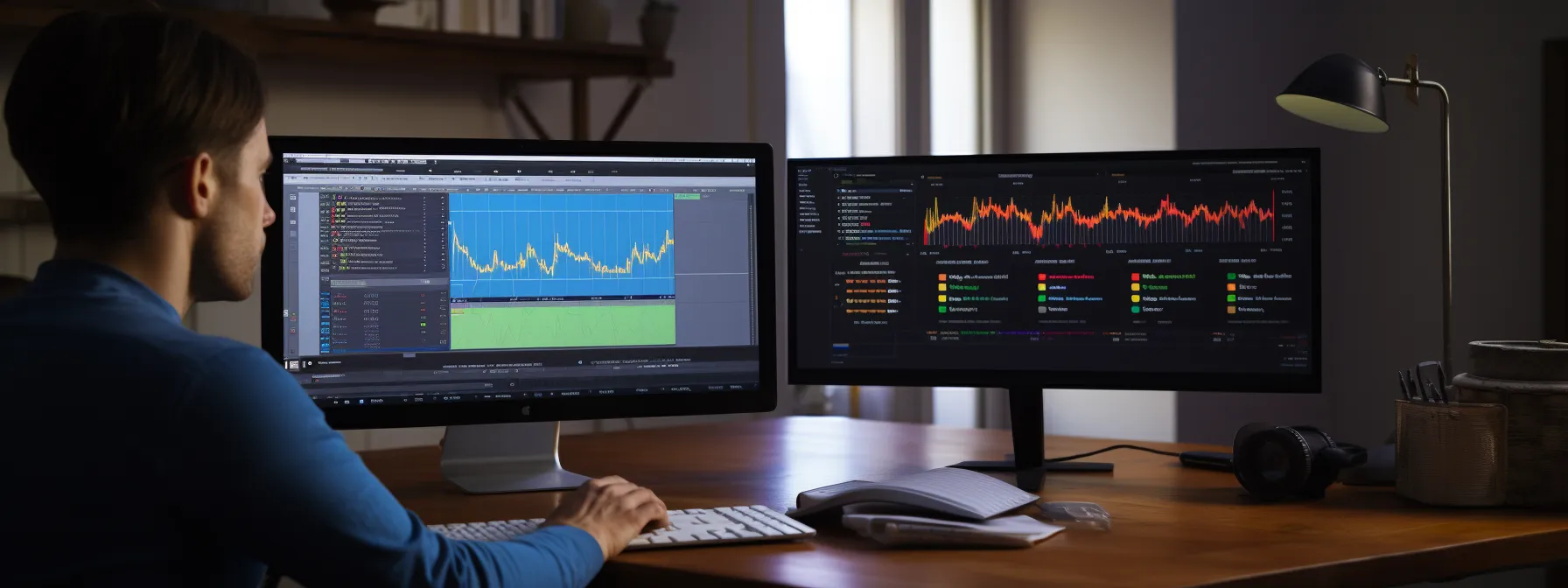Mastering Data: Google Analytics 4 Certification Guide
The advent of Google Analytics 4 marks a significant shift in the landscape of data analytics, ushering in a new era of user-centric insights and cross-platform measurement capabilities.
This refreshed iteration presents a golden opportunity for marketers and business owners alike to fine-tune their strategies based on comprehensive and nuanced user data.
With an intuitive interface and robust reporting tools, Google Analytics 4 empowers you to track and measure the efficacy of digital marketing efforts with unprecedented precision, from search ads to shopping ads.
Mastery of GA4 opens the gateway to data-driven decision-making, setting the foundation for competitive advantage and business growth.
Keep reading to gain a strategic edge through the Google Analytics 4 Certification Guide, your key to navigating this powerful platform.
Key Takeaways
- Google Analytics 4 represents a significant development in data analytics, offering enhanced cross-platform tracking and predictive metrics
- The new GA4 interface provides customization options and a streamlined command center for efficient data analysis
- Marketers can leverage GA4’s advanced analysis techniques, including segmentation and cohort analysis, to uncover actionable insights and forecast user behavior
- Real-time monitoring in GA4 allows for immediate insights and adjustments based on current user interactions and campaign performance
- Focusing on engagement metrics in GA4, such as scroll depth and video consumption, can drive content strategy and improve the user experience
Understanding the Basics of Google Analytics 4

The transition to Google Analytics 4 represents a significant development in the realm of data analytics, offering a future-oriented approach to understanding website and app traffic.
As businesses and marketers acquaint themselves with the platform, they will uncover several pivotal distinctions from its predecessor, Universal Analytics.
By grasping the foundational elements and the core features of GA4, users can tap into new capabilities, such as improved cross-platform tracking and predictive metrics, setting the stage for a more comprehensive data-driven strategy.
Elevate Your Visibility: Unlock SEO Success Today!
Exploring the Key Differences From Previous Versions
Google Analytics 4 marks a paradigm shift in tracking user interactions, adopting an event-based model that departs from the session-based focus of Universal Analytics. This evolution allows for more granular insights into user behavior across devices and platforms, depicting a truer representation of the customer journey.
The introduction of machine learning and AI capabilities in GA4 translates to more advanced predictive analytics, enabling marketers to forecast user actions with greater accuracy. Enhanced privacy controls reflect the changing landscape, ensuring data collection aligns with user consent and regulatory compliance:
| Feature | Universal Analytics | Google Analytics 4 |
|---|---|---|
| Data Model | Session-based | Event-based |
| Predictive Analytics | Limited | Advanced, with AI |
| Privacy Controls | Basic | Stringent |
Identifying the Core Features of GA4
Key to unlocking Google Analytics 4’s potential is the awareness of its core features which support sophisticated analytics. The new GA4 interface is designed to provide an intuitive experience with a focus on customization, allowing users to tailor reports and dashboards to their specific needs. This enhancement facilitates the swift identification of trends and anomalies in data.
The BigQuery export feature of GA4 underscores the platform’s commitment to robust data handling. Marketers now have the capacity to directly link GA4 data to BigQuery, empowering them with the opportunity to execute complex queries and combine various data sources for comprehensive analysis:
| Core Feature | Description |
|---|---|
| Customization | Tailor reports to specific user needs. |
| BigQuery Export | Direct connection to BigQuery for complex data analysis. |
With Google Analytics 4, the emphasis on user engagement is paramount, shifting the narrative away from mere page views to a more substantive grasp of interaction. Additionally, the integration of AI and machine learning equips GA4 to provide advanced insights, predicting future actions and segmenting audiences with precision.
Navigating Through GA4 Interface With Ease

Embarking on the journey toward Google Analytics 4 certification requires familiarity with the platform’s interface to leverage its full suite of features effectively.
A command of the main dashboard and menus forms the bedrock of efficient navigation, leading to astute application of data in practical scenarios.
To enhance analytical acumen, setting up custom reports is integral, empowering professionals to distill complex data into actionable insights tailored to specific organizational objectives.
A Walkthrough of the Main Dashboard and Menus
The Google Analytics 4 dashboard greets users with a streamlined yet powerful interface, designed to surface vital analytics at a glance. Within this centralized command center, users can swiftly access a wealth of data points, including real-time user activity and trend analyses, critical for timely decision-making and strategic adjustments.
Delving deeper into GA4 menus, each section is meticulously orchestrated to enhance user efficiency in data retrieval and interpretation. The intuitive layout ensures that from audience insights to conversion tracking, professionals can navigate with precision to draw out nuanced details pertinent to their marketing campaigns and business growth objectives.
Setting Up Custom Reports for Better Insights
Mastering the creation of custom reports in Google Analytics 4 is a pivotal skill for data-driven decision-making. Custom reports enable a focused analysis by filtering out the noise, zeroing in on data that aligns with specific business objectives and marketing efforts, and thereby empowering businesses with tailored intelligence.
Through a proficiency in configuring custom reports within GA4, marketers can distil voluminous data sets into coherent, actionable insights. This powerful customization allows for the uncovering of trends and user behaviors that standard reports may overlook, leading to more informed strategic choices and optimization of digital touchpoints.
Setting Up Google Analytics 4 Like a Pro

As digital landscapes evolve, marketers and business owners must stay apprised of the tools that spearhead their analytical prowess.
Embarking on the path to Google Analytics 4 certification requires more than a cursory understanding of the platform; it necessitates a hands-on, strategic approach to account creation and data stream management.
Skillfully setting up a GA4 account lays the groundwork for capturing and interpreting complex user interaction data.
Further, adhering to best practices in configuring data streams is quintessential in funneling the right information for precision-driven insights.
Empower your marketing platform with the comprehensive data analysis capabilities of GA4 to enhance marketing efforts across a multitude of digital touchpoints.
Step-by-Step Guide on Creating Your GA4 Account
Initiating a Google Analytics 4 account commences with a visit to the Google Analytics website, where one must click on the ‘Start for free’ button to begin the setup process. Upon navigating through the initial registration, the user is guided to create a property that signifies the analytic entity, be it a website or application, with provisions for detailed configuration in accordance with the business’s specifications.
Following the property creation, the platform prompts users to establish a web data stream, linking their digital property to GA4 seamlessly. Here, one is required to input the website URL and stream name, then carry out a series of guided steps to install the provided tracking code or tag Manager SDK to activate the stream of data. Expert mastery of this critical phase lays the foundation for robust data analytics and insights that drive decision-making.
Best Practices for Configuring Data Streams in GA4
In configuring data streams within Google Analytics 4, meticulous attention to detail is essential. It starts with a clear definition of the user and event parameters, ensuring the accurate tracking of interactions across various touchpoints, whether it be website or app usage.
Professionals should also prioritize the configuration of data retention settings in GA4 to align with company policies and compliance with data governance regulations. This practice ensures a balanced approach to data management, effectively preserving historical data while respecting user privacy and legal boundaries.
Deep Diving Into Data Analysis With GA4

In the quest to harness the full potential of Google Analytics 4, individuals progressing toward certification delve into the sophisticated realm of data analysis, where advanced techniques and AI-driven predictions become indispensable tools.
Embracing these cutting-edge elements, they elevate their analytical expertise, enabling them to not only interpret vast sets of data but also anticipate and strategize based on intelligent forecasts.
This transformative knowledge empowers practitioners to make smarter, data-backed decisions that can significantly impact the success of their marketing initiatives and business outcomes.
Leveraging Advanced Analysis Techniques
Engaging with Google Analytics 4’s advanced analysis techniques unveils the platform’s prowess in deciphering complex data relationships. The intelligent application of segmentation, cohort analysis, and user exploration tools allows marketers to isolate and examine the intricacies of user behavior, unearthing actionable insights that drive targeted strategy refinements.
Analytics professionals leverage GA4’s advanced analysis to identify subtle patterns and trends that inform predictive modelling and customer journey mapping. This robust analytical capability, equipped with AI-driven insights, enhances the mastery of data storytelling, enabling businesses to craft strategic narratives around their audience’s needs and experiences.
Utilizing AI Predictions for Smarter Decision Making
In the contemporary digital arena, Google Analytics 4 serves as a linchpin for astute marketers seeking to leverage the power of AI to predict future user behaviors and market trends. The predictive analytics feature embedded in the GA4 ecosystem provides a data-driven compass that guides business owners in crafting preemptive strategies that align with emergent user interactions and propensities.
Navigating the complex waters of customer journeys becomes less daunting when marketers integrate AI predictions into their decision-making framework. By synthesizing patterns detected within GA4, professionals are equipped to make informed choices that enhance user experience, optimize conversion paths, and drive sustainable revenue growth.
Tracking and Measuring Success in Real-Time

In an era where digital interactions are incessantly unfolding, the facility to track and measure success in real-time becomes indispensable for any marketer aiming for Google Analytics 4 certification.
Real-time monitoring serves as the cornerstone of dynamic web analytics, enabling professionals to garner immediate insights into user engagement metrics and empowered by GA4’s enhanced measurement features.
This arms analysts with the capability to enact timely adjustments and conscious strategy deployment, utilizing data that reflects the most current user interactions and campaign performance.
Focusing on User Engagement Metrics That Matter
Unlocking the full potential of Google Analytics 4 hinges on prioritizing user engagement metrics that directly impact the effectiveness of a website or application. GA4 elevates the standard by which engagement is measured, transitioning from traditional metrics to those that offer a nuanced view of user interactions.
By dissecting engagement metrics such as scroll depth, video consumption, and file downloads, Google Analytics 4 enables marketers to parse through the noise and identify which elements truly resonate with audiences. Identifying these engagement touchpoints assists business owners in refining the user experience and optimizing their websites for heightened interaction and customer satisfaction:
| User Engagement Metric | Importance | Impact |
|---|---|---|
| Scroll Depth | Indicates content relevance | Enhances content strategy |
| Video Consumption | Measures media engagement | Guides multimedia integration |
| File Downloads | Reflects value offered | Improves resource allocation |
Professionals certified in Google Analytics 4 recognize that focusing on engagement metrics informs not only content creation but also reveals usability and design strengths and weaknesses. This discernment is vital for campaign managers aiming to enhance their marketing platform, drive meaningful traffic, and cultivate loyalty through positive user experiences.
Integrating Enhanced Measurement Features Effectively
Effective integration of Google Analytics 4’s enhanced measurement features requires a strategic application of these capabilities to deduce meaningful insights. Configuring the auto-measurement of key events, such as scrolls, outbound clicks, and video engagement, enables meticulous tracking without the need for additional code or tags, streamlining analytical processes.
Accuracy in the implementation of these features is paramount for obtaining reliable data. Marketers and business owners alike should routinely verify and calibrate settings to ensure all interactions are captured as intended, providing a rich tapestry of insights that lead to informed marketing decisions:
- Review auto-measured events for completeness and relevance
- Ensure proper setup of enhanced ecommerce tracking for holistic performance analysis
- Test event tracking configurations and trigger mechanisms regularly for accuracy
Getting Certified in Google Analytics 4

Embarking on a Google Analytics 4 certification journey marks a commitment to proficiency in the nuanced facets of modern data analytics.
Achieving this credential serves as a testament to an individual’s adeptness at navigating the complexities of GA4’s platform, evidencing proficiency in leveraging its comprehensive suite of tools for impactful data interpretation and strategic decision-making.
Navigating the certification process from start to finish requires precision, study, and practical application, and equips professionals with both the skillset and the recognition necessary to excel in analytics-driven roles within the marketing landscape.
Elevate Your Visibility: Unlock SEO Success Today!
Navigating the Certification Process Start to Finish
The journey toward Google Analytics 4 certification commences with a structured learning path that encompasses understanding the principles of Google’s analytics suite. Aspirants are guided through a sequence of educational modules, each designed to convey essential insights inherent to GA4’s functionality.
Following the acquisition of foundational knowledge, candidates face assessment—a series of evaluations testing their grasp of key concepts, analytics practices, and their capacity to apply learned skills in a practical setting. This holistic approach ensures certification holders are well-equipped to manage analytics competently within their professional domain:
| Phase | Activity | Objective |
|---|---|---|
| Learning | Completing educational modules | Understanding GA4 principles |
| Assessment | Participating in practical evaluations | Validating applied analytics skills |
Upon successful completion of assessments, the attainment of the Google Analytics 4 certification confirms an individual’s expertise and preparedness to navigate the dynamic terrain of digital analytics. It is a credential that signals to employers and peers alike a marketer’s proficiency and dedication to data-driven strategies.
Frequently Asked Questions
What are the key differences between Google Analytics 4 and previous versions?
Google Analytics 4 (GA4) represents a paradigm shift from previous versions, such as Universal Analytics, with the introduction of event-based data collection that replaces the session-based model. Unlike its predecessors, GA4 offers cross-platform tracking capabilities, advanced machine learning features, and a more user-centric approach to understanding user journeys, which significantly alters data modelling and reporting tools for marketers and business owners.
How can I set up Google Analytics 4 for my website or app?
To set up Google Analytics 4 (GA4) for a website or application, it begins with the creation of a GA4 property in Google Analytics. Afterward, the process involves configuring a data stream for the desired platform, whether it be for web, an app, or both.
Implementing GA4 efficiently calls for following the correct procedures to install the tracking code on the website or to integrate the relevant SDK for applications. Post-setup, crucial steps include verifying data flow and setting up goals or events to measure user interactions and gauge performance.
How can I effectively navigate and use the GA4 interface for data analysis?
To effectively navigate and utilize the Google Analytics 4 (GA4) interface for data analysis, one should familiarize themselves with the new event-based model, which differs fundamentally from the session-based model of Universal Analytics. Mastery of GA4’s interface involves an understanding of the redesigned reporting tools and web data streams, exploration within the Analysis Hub for advanced insights, and leveraging the ad hoc reporting features that permit a granular examination of user interactions and touchpoints across platforms.
What are the advanced features and capabilities of Google Analytics 4 for tracking and measuring success?
Google Analytics 4, or GA4, introduces a comprehensive suite of features for a deeper understanding of user behaviors, with an emphasis on privacy and cross-platform tracking. It offers enhanced predictive insights, an event-based data model for a more granular look at user interactions, and a flexible approach to measurement, which is more adaptable to the evolving landscape of digital marketing and regulations.
How can I obtain a Google Analytics 4 certification and showcase my expertise in data analytics?
To obtain a Google Analytics 4 Certification and demonstrate expertise in data analytics, individuals should enroll in the Google Analytics Academy and complete the Google Analytics 4 course. Upon successful completion, you’ll secure the credential, underscoring your capability in harnessing GA4 for comprehensive data analytics, which can be a significant asset for any marketer or business owner.
Conclusion
Mastering Data through the Google Analytics 4 Certification Guide is crucial for professionals looking to excel in the rapidly evolving digital marketing landscape.
By thoroughly understanding GA4’s innovative event-based model, predictive analytics, and enhanced privacy controls, marketers can track and analyze user behavior across various platforms with greater granularity.
Embracing core features like customization and BigQuery integration enables the creation of tailored reports for strategic insights.
GA4’s real-time tracking and user engagement metrics further empower marketers to make data-backed decisions and adjustments on-the-fly.
Ultimately, by navigating the certification process and acquiring GA4 expertise, marketing professionals solidify their ability to leverage advanced data analysis techniques, integrate AI predictions, and optimize digital strategies, ensuring their businesses remain competitive and forward-thinking.






